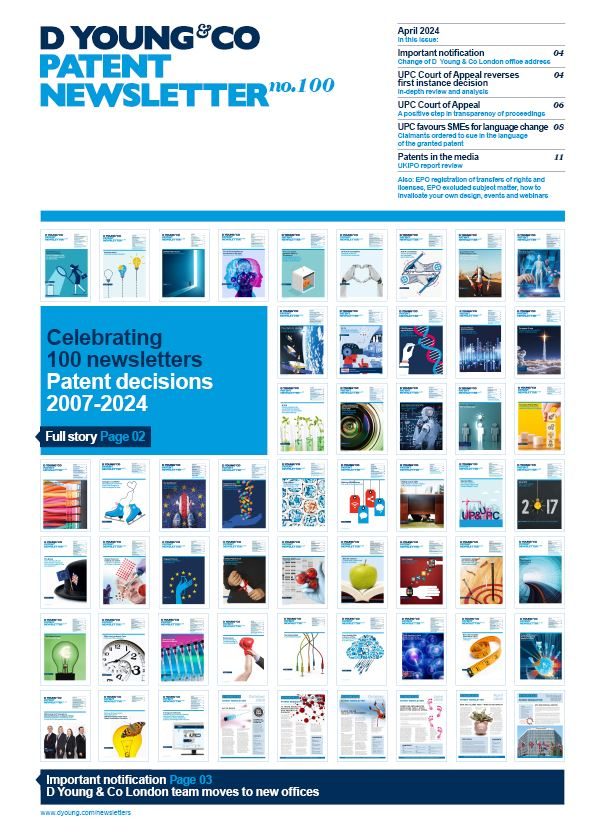Allowed text at the EPO: more than just a formality
A recent Technical Board of Appeal Decision, T506/16 provides an important reminder of the need to check carefully the text of a patent specification allowed by the European Patent Office (EPO).
Background – EPO allowance procedure
After a patent application has been examined by the EPO, and once the examiner is satisfied that the claims are allowable, the examiner issues a communication under Rule 71(3) EPC advising that the EPO intends to grant the application. This communication includes a copy of the allowed text of the patent application, the “Druckexemplar”. This will include any amendments made by the applicant to the claims and description up to this point, as well as any amendments the examiner considers necessary. At this stage the examiner’s amendments will typically address formal requirements, including making sure that the description is in conformity with the final version of claims, clarifying amendments and correction of errors.
The applicant must respond to the communication under Rule 71(3) EPC by either approving the allowed text or proposing amendments.
After several years of prosecuting an application, there is often a temptation for applicants to celebrate once the allowance communication issues, and to consider that the final stages of the EPO procedure are a mere formality. In particular, some clients may carry out only a cursory review of the allowed text, for example by checking only the claims.
T506/16
In this case, the applicant’s representative responded to a communication under Rule 71(3) EPC by requesting correction of some typographical errors in the claims. The applicant submitted amended claims pages including corrections to the relevant claims, but did not include the un-amended claims pages. The applicant explicitly requested that the un-amended claims pages be included together with the amended claims pages. The EPO subsequently issued a new Druckexemplar, but this included only the amended claims pages including the amendments to correct the typographical errors, and did not include the un-amended claims pages, despite the applicant’s request to include these claims. This meant that the Druckexemplar issued with part of claim 1 and claims 2 to 6 missing.
Unfortunately, neither the representative nor the applicant noticed that claims were missing from the allowed text, and the representative subsequently approved the allowed text, and the application proceeded to grant with the incorrect claims.
First instance proceedings
After grant, the patentee realised that the application had granted with the incorrect claims, and requested correction of the B1 publication in accordance with Rule 139 EPC.
Subsequently, the patentee requested correction of a printing error or in the alternative correction of the granted patent under Rule 140 EPC.
The Examining Division decided that the request under Rule 139 EPC was inadmissible. Rule 139 EPC is only available for correction of documents submitted by a party to proceedings, and not for documents issued by EPO departments. Correction of documents under Rule 139 EPC is also only possible for pending applications.
The request for correction of a printing error was also refused by the Examining Division since the errors did not originate from printing process.
The request for correction under Rule 140 EPC was also refused. Rule 140 EPC allows correction of decisions by the EPO, but in accordance with G1/10 this provision is not available to correct patent specifications.
The patentee’s further request to consider the decision to grant null and void and to issue a further allowance communication was also refused, since the decision to grant is binding on the EPO.
Appeal decision
The patentee appealed the decision of the Examining Division not to correct the specification. The patentee’s main request was that the patent be corrected to include the full set of claims 1 to 14. However, the reasoning of the Examining Division was not overturned by the Board of Appeal.
Correction under Rule 140 EPC was not allowed, following the reasoning of G1/10 that this provision was not available to correct patent specifications. The patentee argued that the circumstances of G1/10 differed, since in G1/10 correction was requested during opposition proceedings, and the error was introduced by the applicant. However, the Board of Appeal held that the reasoning of G1/10 was not intended to be limited to correction of errors introduced during opposition proceedings, nor those introduced by the applicant.
Correction of the patent under Rule 139 EPC was also not allowed, following the reasoning of the Examining Division that this provision is not available after grant, and that the existence of pending appeal proceedings is not relevant. They also agreed with the Examining Division that Rule 139 EPC is not available to correct documents produced by the EPO, and that the correction could not be made as correction of a printing error.
The Appeal Board noted that according to G1/10 the applicant has an obligation to check the allowed text for errors prior to grant.
The appellant additionally submitted that the examination proceedings leading to the decision to grant the patent suffered from a substantial procedural violation because the decision was impossible to implement and was not based on an approved text. Therefore, the decision to grant should be set aside. However, the Board of Appeal noted that the patent proprietor had not filed an appeal against the decision to grant, but relied solely on appealing the decision by the Examining Division not to correct the patent specification. Therefore the Board of Appeal could not consider this point.
Conclusion
This decision reminds us of the difficulties in correcting a patent specification post-grant.
The Druckexemplar should be checked carefully by applicants and their representatives. For important cases, an extremely thorough review of the allowed text should be carried out, and it may be worth having the text reviewed by a second attorney. If the worst happens and errors in the specification are identified after grant, please contact your attorney at the earliest opportunity to discuss options.

